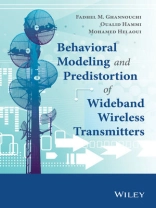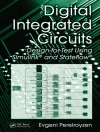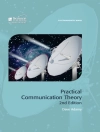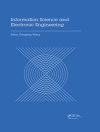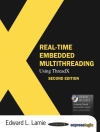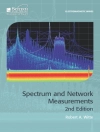Covers theoretical and practical aspects related to the behavioral modelling and predistortion of wireless transmitters and power amplifiers. It includes simulation software that enables the users to apply the theory presented in the book. In the first section, the reader is given the general background of nonlinear dynamic systems along with their behavioral modelling from all its aspects. In the second part, a comprehensive compilation of behavioral models formulations and structures is provided including memory polynomial based models, box oriented models such as Hammerstein-based and Wiener-based models, and neural networks-based models. The book will be a valuable resource for design engineers, industrial engineers, applications engineers, postgraduate students, and researchers working on power amplifiers modelling, linearization, and design.
قائمة المحتويات
Preface
Chapter 1: Characterization of Wireless Transmitter Distortions
1.1 Introduction
1.1.1 RF Power Amplifiers Nonlinearity
1.1.2 Inter-modulation Distortion and Spectrum Regrowth
1.2 Impact of the Distortions on Transmitter Performances
1.3 Output Power versus Input Power Characteristic
1.4 AM/AM and AM/PM Characteristics
1.5 1d B Compression Point
1.6 Third and Fifth Order Intercept Points
1.7 Carrier to Inter-Modulation Distortion Ratio
1.8 Adjacent Channel Leakage Ratio
1.9 Error Vector Magnitude
References
Chapter 2: Dynamic Nonlinear Systems
2.1 Classification of Nonlinear Systems
2.1.1 Memoryless Systems
2.1.2 Systems with Memory
2.2 Memory in Microwave Power Amplification Systems
2.2.1 Nonlinear Systems without Memory
2.2.2 Weakly nonlinear and Quasi-Memoryless Systems
2.2.3 Nonlinear System with Memory
2.3 Baseband and Low-Pass Equivalent Signals
2.4 Origins and Types of Memory Effects in Power Amplification Systems
2.4.1 Origins of Memory Effects
2.4.2 Electrical Memory Effects
2.4.3 Thermal Memory Effects
2.5 Volterra Series Models
References
Chapter 3: Model Performance Evaluation
3.1 Introduction
3.2 Behavioral Modeling vs Digital Predistortion
3.3 Time Domain Metrics
3.3.1 Normalized Mean Square Error
3.3.2 Memory Effects Modeling Ratio
3.4 Frequency Domain Metrics
3.4.1 Frequency Domain Normalized Mean Square Error
3.4.2 Adjacent Channel Error Power Ratio
3.4.3 Weighted Error Spectrum Power Ratio
3.4.4 Normalized Absolute Mean Spectrum Error
3.5 Static Nonlinearity Cancellation Techniques
3.5.1 Static Nonlinearity Pre-Compensation Technique
3.5.2 Static Nonlinearity Post-Compensation Technique
3.5.3 Memory Effects Intensity
3.6 Discussion and Conclusion
References
Chapter 4: Quasi-Memoryless Behavior Models
4.1 Introduction
4.2 Modeling and Simulation of Memoryless/Quasi-Memoryless Nonlinear Systems
4.3 Bandpass to Baseband Equivalent Transformation
4.4 Look-up Table Models
4.4.1 Non-uniform Indexed Look-up Tables
4.5 Empirical Analytical Based Models
4.5.1 Class AB Amplifier Behavior Model
4.6 Saleh Based Models
4.6.1 Polar Saleh Model
4.6.2 Cartesian Saleh Model
4.6.3 Frequency-dependent Saleh Model
4.6.4 Ghorbani Model
4.6.5 Berman & Mahle Phase Model
4.6.6 Thomas-Weidner-Durrani Amplitude Model
4.6.7 Limiter Model
4.6.8 ARCTAN Model
4.6.9 Rapp Model
4.6.10 White Model
4.7 Power Series Models
4.7.1 Polynomial Model
4.7.2 Bessel Function Based Model
4.7.3 Chebyshev Series Based Model
4.7.4 Gegenbauer Polynomials Based Model
4.7.5 Zernike Polynomials Based Model
References
Chapter 5: Memory Polynomial Based Models
5.1 Introduction
5.2 Generic Memory Polynomial Model Formulation
5.3 Memory Polynomial Model
5.4 Variants of the Memory Polynomial Model
5.4.1 Orthogonal Memory Polynomial Model
5.4.2 Sparse-Delay Memory Polynomial Model
5.4.3 Exponentially Shaped Memory Delay Profile Memory Polynomial Model
5.4.4 Non-uniform Memory Polynomial Model
5.4.5 Unstructured Memory Polynomial Model
5.5 Envelope Memory Polynomial Model
5.6 Generalized Memory Polynomial Model
5.7 Hybrid Memory Polynomial Model
5.8 Dynamic Deviation Reduction Volterra Model
5.9 Comparison and Discussion
References
Chapter 6: Box-Oriented Models
6.1 Introduction
6.2 Hammerstein and Wiener Models
6.2.1 Wiener Model
6.2.2 Hammerstein Model
6.3 Augmented Hammerstein and Weiner Models
6.3.1 Augmented Wiener Model
6.3.2 Augmented Hammerstein Model
6.4 Three-Box Wiener-Hammerstein Models
6.4.1 Wiener-Hammerstein Model
6.4.2 Hammerstein-Wiener Model
6.4.3 Feed-Forward Hammerstein Model
6.5 Two-Box Polynomial Models
6.5.1 Models Description
6.5.2 Identification Procedure
6.6 Three-Box Polynomial Models
6.6.1 Parallel Three-blocks Model – Plume Model
6.6.2 Three layered biased memory polynomial Model
6.6.3 Rational Function Model for Amplifiers
6.7 Polynomial based Model with I/Q and DC impairments
6.7.1 Parallel Hammerstein (PH) based model for the alleviation of various imperfections in Direct Conversion transmitters
6.7.2 Two-Box Model with I/Q and DC Impairments
References
Chapter 7: Neural Network Based Models
7.1 Introduction
7.2 Basics of Neural Networks
7.3 Neural Networks Architecture for Modeling of Complex Static Systems
7.3.1 Single-Input Single-Output Feedforward Neural Network (SISO-FFNN)
7.3.2 Dual-Input Dual-Output Feedforward Neural Network (DIDO-FFNN)
7.3.3 Dual-Input Dual-Output Coupled Cartesian based Neural Network (DIDO-CC-NN)
7.4 Neural Networks Architectures for Modeling of Complex Dynamic Systems
7.4.1 Complex Time-Delay Recurrent Neural Network (CTDRNN)
7.4.2 Complex Time-Delay Neural Network (CTDNN)
7.4.3 Real Valued Time-Delay Recurrent Neural Network (RVTDRNN)
7.4.4 Real Valued Time-Delay Neural Network (RVTDNN)
7.5 Training Algorithms
7.6 Conclusion
References
Chapter 8: Characterization and Identification Techniques
8.1 Introduction
8.2 Test Signals for Power Amplifiers and Transmitters Characterization
8.2.1 Characterization using Continuous Wave Signals
8.2.2 Characterization using Two-Tone Signals
8.2.3 Characterization using Multi-Tone Signals
8.2.4 Characterization using Modulated Signals
8.2.5 Characterization using Synthetic Modulated Signals
8.2.6 Discussion: Impact of Test Signal on the Measured AM/AM and AM/PM Characteristics
8.3 Data De-embedding in Modulated Signals Based Characterization
8.4 Identification Techniques
8.4.1 Moving average Techniques
8.4.2 Model Coefficient Extraction Techniques
8.5 Robustness of System Identification Algorithms
8.5.1 The LS Algorithm
8.5.2 The LMS Algorithm
8.5.3 The RLS Algorithm
8.6 Conclusions
References
Chapter 9: Baseband Digital Predistortion
9.1 The Predistortion Concept
9.2 Adaptive Digital Predistortion
9.2.1 Closed Loop Adaptive Digital Predistorters
9.2.2 Open Loop Adaptive Digital Predistorters
9.3 The Predistorter’s Power Range in Indirect Learning Architectures
9.3.1 Constant Peak Power Technique
9.3.2 Constant Average Power Technique
9.3.3 Synergetic CFR and DPD Technique
9.4 Small Signal Gain Normalization
9.5 Digital Predistortion Implementations
9.5.1 Baseband Digital Predistortion
9.5.2 RF Digital Predistortion
9.6 The Bandwidth and Power Scalable Digital Predistortion Technique
References
Chapter 10: Advanced Modeling and Digital Predistortion
10.1 Joint Quadrature Impairment and Nonlinear Distortion Compensation
10.1.1 Modeling of Quadrature Modulator Imperfections
10.1.2 Dual-Input Polynomial Model for Memoryless Joint Modeling of Quadrature Imbalance and PA Distortions
10.1.3 Dual-Input Memory Polynomial for Joint Modeling of Quadrature Imbalance and PA Distortions Including Memory Effects
10.1.4 Dual-Branch Parallel Hammerstein Model for Joint Modeling of Quadrature Imbalance and PA Distortions with Memory
10.1.5 Dual-Conjugate-Input Memory Polynomial for Joint Modeling of Quadrature Imbalance and PA Distortions Including Memory Effects
10.2 Modelling and Linearization of Nonlinear MIMO Systems
10.2.1 Impairments in MIMO Systems
10.2.2 Crossover Polynomial Model for MIMO Transmitters
10.2.3 Dual-Input Nonlinear Polynomial Model for MIMO Transmitters
10.2.4 MIMO Transmitters Nonlinear Multi-variable Polynomial Model
10.3 Modelling and Linearization of Dual Band Transmitters
10.3.1 Generalization of the Polynomial Model to Dual-Band Case
10.3.2 Two-Dimensional (2-D) Memory Polynomial Model for Dual-Band Transmitters
10.3.3 Phase-Aligned Multi-band Volterra DPD
10.4 Application of MIMO and Dual-band Models in Digital Predisortion
10.4.1 Linearization of MIMO Systems with Nonlinear Crosstalk
10.4.2 Linearization of Concurrent Dual-Band Transmitters using 2D Memory Polynomial Model
10.4.3 Linearization of Concurrent Tri-Band Transmitters using 3D Phase-Aligned Volterra Model
10.5 References
Index
عن المؤلف
Fadhel M. Ghannouchi University of Calgary, Canada
Oualid Hammi King Fahd University of Petroleum and Minerals, Saudi Arabia
Mohamed Helaoui University of Calgary, Canada
